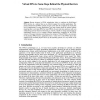Free Online Productivity Tools
i2Speak
i2Symbol
i2OCR
iTex2Img
iWeb2Print
iWeb2Shot
i2Type
iPdf2Split
iPdf2Merge
i2Bopomofo
i2Arabic
i2Style
i2Image
i2PDF
iLatex2Rtf
Sci2ools
IPPS
1998
IEEE
1998
IEEE
Virtual FPGAs: Some Steps Behind the Physical Barriers
Recent advances in FPGA technologies allow to configure the RAM-based FPGA devices in a reduced time as an effective support for real-time applications. The physical dimensions of FPGAs (pinout and gate count) limit the complexity of circuits that can be implemented. In many applications, very large circuits should be realized without requiring either a very large FPGA or many FPGAs; in some real-time systems as well as in multitasking and time-shared environments, it could be valuable to change dynamically the implemented circuit so as to support different applications competing for the FPGA resource. This paper introduces and discusses the concept of Virtual FPGA as an extension of the physical FPGA device: applications have a virtual view of the FPGA that is then mapped on the available physical device by the operating system, in a way similar to the virtual memory.
| Added | 05 Aug 2010 |
| Updated | 05 Aug 2010 |
| Type | Conference |
| Year | 1998 |
| Where | IPPS |
| Authors | William Fornaciari, Vincenzo Piuri |
Comments (0)

